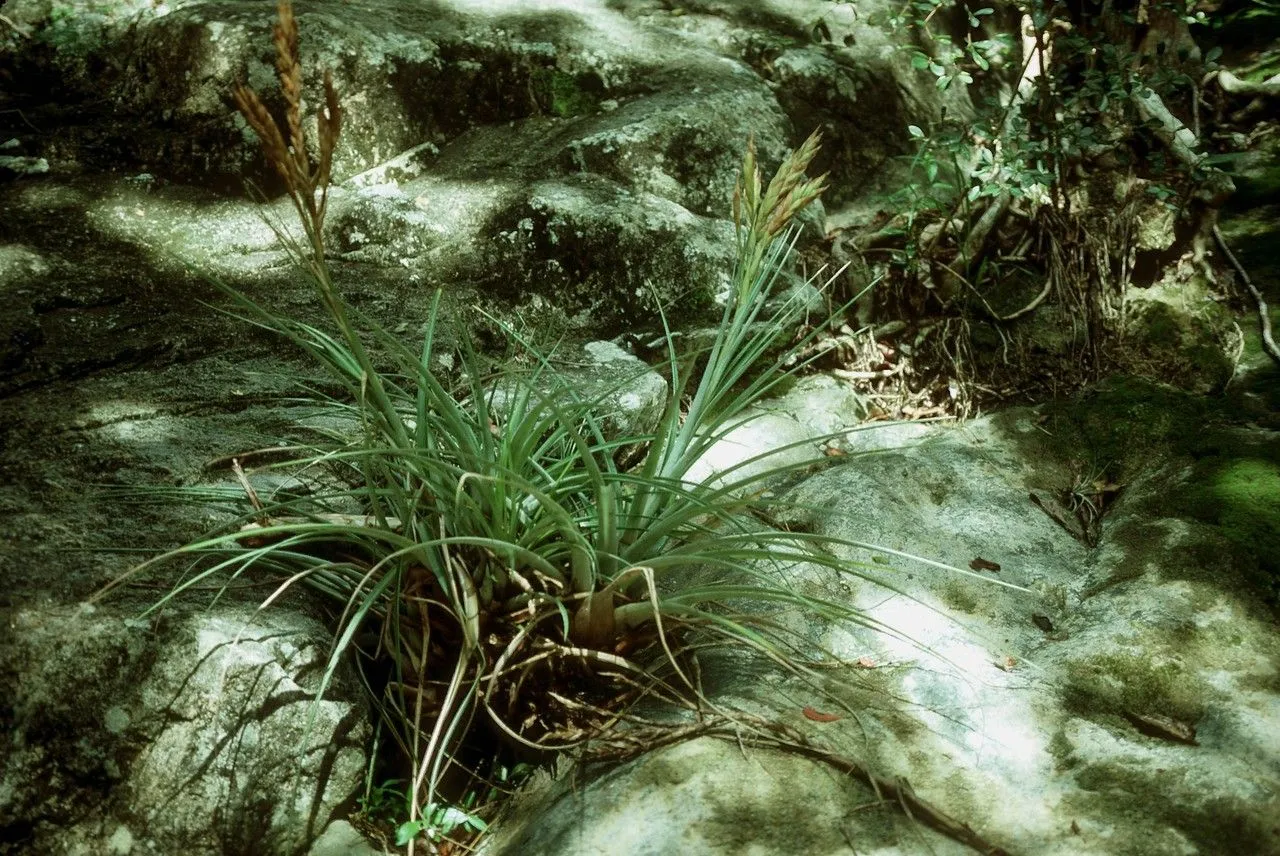
Author: Sw.
Bibliography: Prodr. Veg. Ind. Occ.: 56 (1788)
Year: 1788
Status: accepted
Rank: species
Genus: Tillandsia
Vegetable: False
Observations: Florida to N. Brazil
The Giant Airplant, known scientifically as Tillandsia fasciculata, is a fascinating and unique member of the Bromeliaceae family. First described by Sw. in 1788 in the seminal work “Prodr. Veg. Ind. Occ.: 56”, this remarkable plant has captured the interest of botanists and plant enthusiasts alike.
Native to a broad range of the Americas, the Giant Airplant is found from the sunny shores of Florida to the tropical regions of northern Brazil. It thrives in a variety of habitats, typically seen clinging to tree branches in dense forests, where it absorbs moisture and nutrients directly from the air—a characteristic trait of epiphytic plants.
The appearance of Tillandsia fasciculata is defined by its rosette of stiff, narrow leaves which often display an attractive silvery-gray hue due to the presence of trichomes. These specialized structures not only give the plant its distinctive coloration but also aid in capturing water and nutrients from the atmosphere. Its vibrant inflorescence, usually a striking red or yellow, emerges from the center of the rosette, making it a visually arresting sight when in bloom.
Beyond its aesthetic appeal, the Giant Airplant plays an integral ecological role within its environment. It provides habitat and resources for a variety of insects and small animals, contributing to the biodiversity of the regions it inhabits. Despite its epiphytic lifestyle, which sometimes leads to misconceptions about its parasitic nature, the Giant Airplant lives harmoniously with its host trees without causing them harm.
Due to its adaptability and minimal soil requirements, Tillandsia fasciculata has also gained popularity among horticulturists and indoor plant enthusiasts. It is cherished not only for its exotic beauty but also for its relatively low maintenance needs, requiring only regular misting and appropriate light conditions to thrive in a home setting.
Understanding and preserving the natural habitats of plants like the Giant Airplant is crucial, as these species are often indicators of environmental health. Their presence in diverse regions from Florida to northern Brazil highlights the intricate web of ecological relationships that sustain our planet’s biodiversity. By studying and appreciating the Giant Airplant, we can gain deeper insights into the delicate balance of our natural world and the remarkable adaptability of life.
Eng: giant airplant, cardinal air plant, giant air plant
Spa: tillandsia espigas erectas
En: Giant airplant, Quill leaf, Wild pine, Cardinal Air Plant, Giant Air Plant
Ko: 홍관조틸란드시아
Es: Piñuela, Parásita, Epífita, Bromelia., Tillandsia espigas erectas
© copyright of the Board of Trustees of the Royal Botanic Gardens, Kew.
Taken Aug 17, 2021 by González Julio (cc-by-sa)
Taken Aug 24, 2022 by Marzanna Bug (cc-by-sa)
Taken Jan 31, 2021 by Chris Ballard (cc-by-sa)
Taken Jan 31, 2021 by Chris Ballard (cc-by-sa)
Taken Dec 16, 2020 by Eric Pullen (cc-by-sa)
Taken Jan 1, 1900 by EOL − Acevedo, P. (cc-by-nc-sa)
Taken Nov 26, 2014 by EOL − Angel Fernando Valentinez Villaseca (cc-by-nc-sa)
Taken Jan 29, 2015 by EOL − Royal Tyler (cc-by-nc-sa)
Taken Mar 22, 2015 by EOL − cdmar10 (cc-by)
Taken Feb 18, 2015 by EOL − Neptalí Ramírez Marcial (cc-by-nc)
Taken Jul 25, 2022 by Anatas (cc-by-sa)
Taken Feb 17, 2022 by jacques maréchal (cc-by-sa)
Taken Oct 17, 2019 by Malena Malena (cc-by-sa)
Taken Oct 10, 2019 by Valeria (cc-by-sa)
Taken Aug 26, 2021 by Christine Yee (cc-by-sa)
Taken Jan 19, 2021 by Shehadi Ramiz (cc-by-sa)
Taken Mar 18, 2016 by EOL − David Kaposi (cc-by-nc)
Taken May 19, 2015 by EOL − Zabdiel Peralta (cc-by-nc-sa)
Taken Jan 24, 2021 by Walter Knudsen (cc-by-sa)
Taken Mar 25, 2020 by xavier dejonghe (cc-by-sa)
Growth habit>: Forb/herb
Family: Myrtaceae Author: (F.Muell.) K.D.Hill & L.A.S.Johnson Bibliography: Telopea 6: 402 (1995) Year: 1995 Status:…
Family: Rubiaceae Author: Pierre ex A.Froehner Bibliography: Notizbl. Bot. Gart. Berlin-Dahlem 1: 237 (1897) Year:…
Family: Sapindaceae Author: Koidz. Bibliography: J. Coll. Sci. Imp. Univ. Tokyo 32(1): 38 (1911) Year:…
Family: Asteraceae Author: A.Gray Bibliography: Pacif. Railr. Rep.: 107 (1857) Year: 1857 Status: accepted Rank:…
Family: Fabaceae Author: Medik. Bibliography: Vorles. Churpfälz. Phys.-Ökon. Ges. 2: 398 (1787) Year: 1787 Status:…
Family: Aspleniaceae Author: (Cav.) Alston Bibliography: Bull. Misc. Inform. Kew 1932: 309 (1932) Year: 1932…